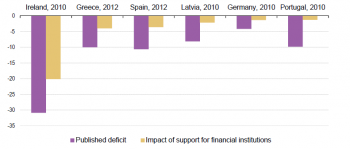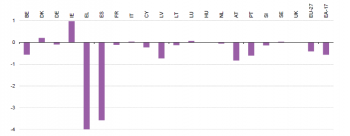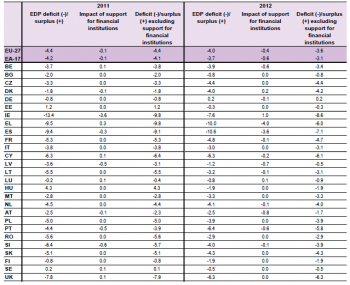Archive:Impact of support for financial institutions on government deficits
Support for financial institutions increases government deficits in 2012
Statistics in focus 10/2013; Author: Martynas BACIULIS
ISSN:2314-9647 Catalogue number:KS-SF-13-010-EN-N
This article is outdated and has been archived. For recent articles on Government finance, please see here,
In 2012 public interventions to support financial institutions, notably in the form of bank recapitalisations, increased government deficits in a majority of Member States that reported such interventions. The increase was particularly large in Greece (4.0 percentage points of GDP) and Spain (3.6pp GDP).
This issue of ‘Statistics in focus’ covers the impact on government deficit/surplus for individual Member States and European aggregates. These impacts can be substantial, as illustrated in Figure 1 which compares the published general government deficit and the net impact of government interventions to support financial institutions.
Main statistical findings
Background
The ongoing financial crisis, which first affected EU Member States in the summer of 2007, has been addressed by public interventions of unprecedented magnitude. These interventions took various forms, ranging from direct support for financial institutions, to monetary policy operations aimed at preserving the financial stability, to general economic support measures as part of fiscal policy.
Eurostat started collecting data on the actual and potential impacts on government deficit and debt, directly relating to the support for financial institutions, in October 2009.
Figure 1 shows that the largest impacts to date were recorded in 2010 and 2012. It is likely that support for financial institutions will continue to have a substantial impact on government deficit/surplus of individual EU Member States in 2013.
Such largely one-off impacts are often excluded in fiscal analysis, for instance, when assessing compliance with the EU-IMF programme targets. Therefore Eurostat is publishing, for the first time, government deficit/surplus figures excluding the net impact of interventions during the financial crisis. For this adjusted deficit/surplus measure relating to the EU, the euro area and individual Member States, please refer to the last section of this ‘Statistics in focus’.
Impact on 2012 government deficit/surplus
In 2012 public interventions to support financial institutions increased government deficits in 13 out of 19 Member States that reported such interventions. Eight Member States did not report any such interventions.
The increase in deficits was particularly large in Greece and Spain. The Greek deficit increased by 4.0pp GDP and the Spanish deficit by 3.6pp, largely due to the resolution and recapitalisation of a number of banks.
These capital injections were treated as deficit increasing capital transfers (government expenditure), and not as financial transactions (acquisition of equity), since they were assessed to be covering losses. For further information on the applicable statistical framework, please refer to the chapter Data sources and availability.
It is worth noting that all capital injections, whether they are treated as government expenditure or as acquisition of equity, generally affect government debt, as governments need to finance them. In 2012, the overall impact on government debt resulting from past and present support for financial institutions was estimated at 5.2 % of GDP for the EU and 5.5 % for the euro area.
Other cases of noticeable increases in the 2012 deficit (more than 0.2pp GDP) involved Belgium, Cyprus, Latvia, Austria and Portugal.
In some EU Member States (Denmark, Ireland, Italy, Luxembourg, Hungary and Sweden) government deficits in 2012 were reduced overall due to government interventions. This resulted from fees on guarantees granted to financial institutions, property income (interest and dividends) receivable from financial instruments acquired by governments, and from other revenue such as capital taxes.
The impact on 2012 government deficit/surplus in the EU, the euro area and the Member States that reported interventions to support financial institutions is summarised in figure 2.
Impact on 2007-2011 government deficit/surplus
Figure 3 shows that the largest government interventions to date occurred in 2010. Data for the year 2007 are not included in this figure, as interventions were undertaken only by the United Kingdom.
Overall, the most significant increase in deficit due to government interventions in financial institutions is noted for Ireland (more than 26pp GDP, cumulated over the reference period of 2007-2011). This impact was mainly due to major capital injections into banks.
For several other EU Member States, such as Germany, Spain, Latvia, the Netherlands, Austria, Portugal, Slovenia and the United Kingdom, the deficit increased by a significant, but more limited, extent: from around 0.5pp to 3pp over the reference period. These impacts on government deficit mainly reflect recapitalisations of financial institutions.
Lithuania also reported an increase in the deficit, but for a much smaller amount. In other EU Member States government deficits were marginally reduced due to revenues from government interventions.
The impact of interventions on government deficit in the euro area and the EU, including the data for 2012, is summarised in figure 4. Both for the EU and the euro area, the net impact was marginally deficit-increasing in 2007, 2008 and 2009, became much more pronounced in 2010 and decreased sharply in 2011. The net impact was noticeably deficit-increasing again in 2012, largely due to bank recapitalisations and resolutions.
A spike in government expenditure for 2010 was mainly due to massive capital transfers to Irish banks as well as federal and state-level liquidation agencies in Germany.
Government deficit/surplus excluding the impact of support for financial institutions
Table 1 shows government deficit/surplus data for 2011 and 2012, excluding the impacts of government interventions to support financial institutions.
As described above, these impacts may be positive (as some governments receive substantial related revenue, for example interest and guarantee fees) or negative (notably due to capital injections into banks and other financial institutions, treated as deficit-increasing capital transfers). For example, Spain’s deficit excluding both positive and negative impacts is shown as -7.1 % in the table below, but if limited to the negative one-off capital transfers, the figure is -7.0 %.
The calculation of these impacts is further explained in the chapter Data sources and availability. Please allow for rounding effects, as all ratios in table 1, including the adjusted measure of government deficit/surplus, are rounded to the nearest decimal.
It should also be noted that this adjusted measure of government deficit/surplus is only intended to be an improvement in the presentation of data for users. This measure is not used for assessment in the context of the Excessive Deficit Procedure.
Data sources and availability
Reporting of data to Eurostat: Eurostat collects from Member States a set of supplementary data on the financial crisis, following its decision of 15 July 2009 on the statistical recording of public interventions to support financial institutions and financial markets during the financial crisis.
This decision provides a general framework of statistical rules (fully consistent with the European System of Accounts (ESA95)) and covers main forms of public interventions, notably recapitalisation, guarantees, purchase of assets, financial defeasance, liquidity operations conducted through exchange of assets, and the creation of temporary special purpose entities.
Calculation of net impact of government support for financial institutions: Government revenue and expenditure, relating to support for financial institutions and recorded in the national accounts for the General Government sector (S.13), are reported in Part 1 of the supplementary table for the financial crisis. The following elements of government revenue are reported: guarantee fees, interest and dividends receivable.
Similarly, the following elements of government expenditure are reported: interest payable, capital injections recorded as deficit-increasing capital transfers (please refer to the section below) and calls on guarantees.
Amounts relating to any transactions not falling under the most common types of revenue and expenditure listed above are reported under the residual (‘other’) lines (for both revenue and expenditure). These can cover, for example, expenditure on commission fees relating to special entities involved in the financial crisis or revenue fees on securities issued under special liquidity schemes. Member States may also report specific transactions (for instance, large capital transfers) under this item for transparency reasons.
The net impact on government deficit/surplus (line C of the supplementary table) is calculated as the difference between total revenue (line A) and total expenditure (line B).
Statistical treatment of capital injections: The statistical treatment of capital injections is defined in chapter III.2 of the ESA95 Manual on Government Deficit and Debt (MGDD).
A payment from the government to (re)capitalise a corporation, commonly referred to as a ‘capital injection’, is either recorded as a financial transaction (normally, an addition to equity (F.5) – or, in other cases, to loans (F.4) or securities other than shares (F.3)), recorded in the financial account with no impact on government deficit/surplus, or as a non-financial transaction (capital transfer (D.9)), that is government expenditure with a negative impact on deficit/surplus. In some specific cases, the recording could be a combination of the two, a financial transaction and a non-financial transaction.
To further clarify the rules applicable to the special case of capital injections into financial institutions, Eurostat published two guidance notes: on the statistical recording of public interventions to support financial institutions and financial markets during the financial crisis on 29 September 2009 and on the impact of bank recapitalisations on government finance statistics during the financial crisis on 18 July 2012.
The statistical treatment of capital injections into financial institutions depends on the circumstances of the recapitalisation:
- Where government purchases, without taking control of the financial institution, shares traded on an active market, it is necessary to compare the price paid by the government with the prevailing market price. Any excess of the price paid by the government over the prevailing market price is recorded as a deficit-increasing capital transfer.
- Where government purchases, without taking control of the financial institution, shares traded on an active market, it is necessary to compare the price paid by the government with the prevailing market price. Any excess of the price paid by the government over the prevailing market price is recorded as a deficit-increasing capital transfer.
More challenging cases where the injection is not in the form of traded shares or other above-mentioned instruments, commonly when government injects funds into a private institution without any contribution by private shareholders or into a public financial institution (that is an institution already under its control) are dealt with under the general framework defined in MGDD.
Context
This statistical article gives some background explanation on the basis for collection of supplementary data on financial crisis, on the calculation of net impact of government support for financial institutions, and on the statistical treatment of capital injections. More exhaustive information and data can be found in the dedicated section of the Eurostat website.
See also
Further Eurostat information
Publications
Main tables
Database
Dedicated section
Methodology / Metadata
- Government deficit and debt (ESMS metadata file - gov_dd_esms)
- Public procurement advertised in the Official Journal (as a % of total public procurement and as a % of GDP) (ESMS metadata file - gov_oth_procur_esms)
- Quarterly financial accounts for general government (ESMS metadata file - gov_q_ggfa_esms)
- Quarterly government debt (ESMS metadata file - gov_q_ggdebt_esms)
- Quarterly non-financial accounts for general government (ESMS metadata file - gov_q_ggnfa_esms)




